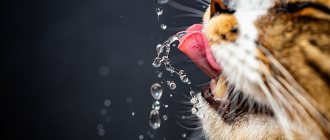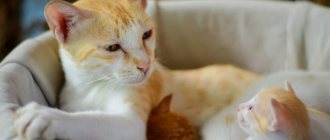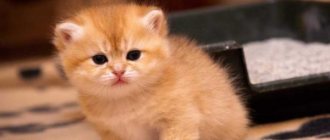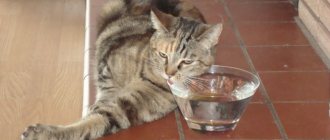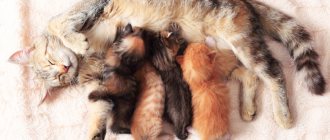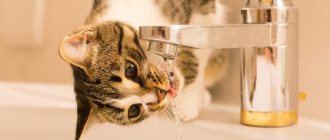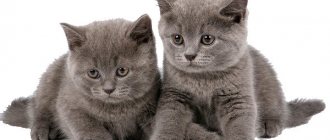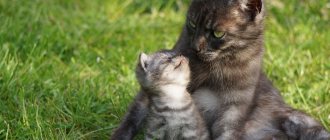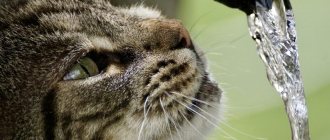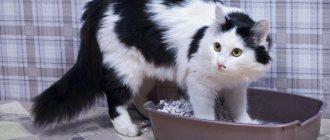A cat's body is 65% fluid. A pet's diet must include not only tasty and high-quality food, but also clean drinking water, which is of great importance for the body. Water takes part in many important life processes and helps dissolve substances entering the digestive tract.
In this article we will look at how to properly give a cat water, how much liquid a cat should be given per day, how to prepare water for drinking, methods for accustoming a cat to water, and answers to popular questions.
How much water should a cat drink per day?
Cats do not need a lot of liquid, but your pet's daily diet must include clean water. Broths and other liquid formulations cannot fully replace regular drinking water. The average daily water intake for a cat is 40-50 ml of liquid per 1 kg of weight.
If a cat eats wet food and eats other nutritious foods well, a certain portion of its daily fluid intake will enter its body. She gets the rest with drinking water. This is why the owner often thinks that the cat does not drink water at all or drinks very little.
Daily fluid intake
According to veterinarians, a cat's daily water intake should be 20-40 milliliters of water per 1 kilogram of weight. For kittens, this figure is doubled or tripled, since the growing body requires more moisture for new cells. For this reason, the diet of animals under three months of age should consist only of wet food.
The indicated rate of water consumption for a cat is average. Deviations are possible due to a number of aspects.
- Feed. If your pet eats only dry food, the amount of water it consumes should be three times the amount of pellets it eats.
- Dimensions. The lower the weight of the animal, the higher its need for fluid per 1 kilogram of body weight.
- Activity . Exclusively indoor cats are usually less active than their counterparts who periodically walk outside, and therefore drink less.
- Pregnancy and lactation. A pregnant or lactating cat needs plenty of fluids. Moisture is needed to produce additional blood, amniotic fluid and milk for kittens.
- Ambient temperature. During the hot season, cats require more fluid due to the increasing load on the thermoregulatory system. They lick themselves vigorously and, thanks to the evaporation of saliva, tolerate the heat more easily. In addition, a certain amount of liquid evaporates from the surface of the mucous membranes when a hot animal breathes with its mouth open.
What kind of water to give your cat
The health and life expectancy of a cat largely depends on the quality of drinking water. The best option for an animal is soft natural water from drinking sources. This water contains beneficial microelements for the body.
Alternatively, you can give your cat filtered or frozen water. Do not give your domestic cat water from the tap. As a rule, it is not of good quality. In addition, it may contain impurities that are dangerous to the cat’s body.
Preparation
The cat is given drinking water in a clean ceramic or glass bowl. The container must be washed daily.
Temperature
Do not give your pet too cold or hot water. The liquid should be at room temperature.
Supplements
Some owners add various additives to their cat’s water to improve the taste or quality of the drinking composition.
Water additives:
- fluorine, iodine (quality improves);
- tuna juice, anchovies (cats are attracted by the smell);
- nettle infusion (for medicinal purposes);
- special nutritional drink for cats.
The cat is thirsty
Thirst is the feeling that initiates the consumption of water. The corresponding signal comes from the lateral part of the hypothalamus, adjacent to the hunger center. The regulation of water intake is complex and closely related to the variability of blood plasma osmolality, which is controlled by the hormone vasopressin.
The feeling of quenching thirst begins from the moment of stimulation of the oral cavity with water and does not last long. Later, the expansion of the stomach begins to have an effect, and its severity is determined mainly by the frequency of the animal’s intake of water.
Cats are not as sensitive to water loss as dogs and do not become thirsty until such loss exceeds 8% of their body's water supply.
The level of water consumption directly depends on all its losses by the body:
- physiological losses: with urine, feces, exhaled air and milk;
- pathological losses: with diarrhea, vomiting, edema, skin injuries, diabetes, renal failure, etc.
A decrease in blood pressure and volume also provokes thirst due to the activation of hormones of the renin-angiotensin-aldosterone system
Answers on questions
Each cat is individual. Some simply drink water without creating any problems for the owner, while other representatives of the feline family are afraid of any liquid and categorically refuse to put their muzzle in a bowl so as not to wet their whiskers.
We have prepared answers to the most common questions that owners of pet cats and cats have.
The cat does not drink water: what to do
A cat's reluctance to drink water may alert the owner.
Insufficient fluid intake leads to dehydration of the body, disrupts the biochemical parameters of the blood, which in turn provokes the development of severe liver and kidney diseases. Before taking measures to correct this situation, you need to determine the reason for the cat’s refusal to drink fluids. Reasons why a cat does not drink water:
- The cat eats wet food. They contain up to 80% liquid, which is quite enough for the animal’s body.
- Reluctance to drink from an uncomfortable bowl. You can try changing the water tank to another one with wider edges, so that it is more convenient for the cat to lap up the water.
- Stale or poor quality water. Cats are very finicky and may refuse to take liquid if it does not meet their needs.
- Serious illness. As a rule, in such cases, the cat refuses not only water, but also food, or consumes it in smaller quantities, without showing much appetite. In this case, the animal needs to be shown to a veterinarian.
Try to find out the reason for the cat's refusal of water. Observe her and if you see that she drinks water from other sources, but categorically refuses to lap up the liquid from her bowl, try replacing it or placing it away from the food bowl. Some cats generally do not drink water if it is next to food.
Special additives that improve the taste and quality of the liquid will also help to accustom your cat to water. Some breeders add a pinch of soda to drinking water or throw an ice cube into a bowl of water. Cats are very curious and may become interested in water if something foreign is floating in it.
If your cat is often outside, there is a high chance that she is getting the amount of fluid she needs from outside sources. These could be ordinary puddles, which, of course, is very unsafe. In this case, the animal can only be retrained by limiting its access to the street for independent walks.
Is it normal for a cat to drink a lot of water?
Excessive water consumption is a clear sign of extreme thirst, which may indicate the development of certain diseases in the cat's body. This symptom is typical for hormonal disorders, diabetes, kidney disease, infectious diseases and febrile conditions.
If your cat drinks a lot of water and there are additional signs of her unhealthy condition, you should immediately take her to a veterinarian, who can determine the exact problem of her unhealthy interest in drinking liquids.
There is no need to worry if a cat that regularly eats dry food drinks a lot of water. With such a diet, the animal must consume a sufficient amount of liquid per day.
Can cats drink sea and salt water?
Cats located far from fresh water can quench their thirst with sea water. Their body filters salt well and removes the unnecessary element naturally. There will be no harm to your cat after drinking salt water, but you should not give it to your cat for daily drinking.
Should I give my cat mineral water?
There are times when a cat accidentally drinks mineral water from its owner’s mug and shows with all its appearance that it quite liked this liquid. Should you give your cat mineral water? Absolutely not, only in the absence of fresh water or for medicinal purposes, as prescribed by a veterinarian. If you regularly give your cat mineral water, urolithiasis may develop.
Should you give your cat boiled water?
Boiled water has a specific taste and, as a rule, cats do not particularly like it. In addition, it is completely useless for the body, so it is not recommended to give such water to a domestic cat. It is better to choose filtered, frozen or bottled water for drinking your pet.
Why does a cat move or overturn the bowl and spill water?
The cat spills water, moves the bowl - what to do? Many animals simply play with water, trying to entertain themselves with something. The reason for this behavior may also be the proximity of the food bowl. Try moving the water container to a different location.
And with this behavior, a cat may indicate the need to change stagnant water to clean and fresh. Change the fluid, not forgetting to rinse the reservoir itself thoroughly.
Watch your cat and learn to recognize her desires! Don't ignore the problem of water refusal or excessive thirst. In any unclear situation, contact your veterinarian.
Reasons for drinking heavily
High-quality lactation requires more water consumption by animals.
When a kitten or adult cat absorbs a large volume of water, and there is a strong belief that he is healthy, sources of excessive fluid absorption should be sought in external factors. Dry and hot air can provoke thirst: in summer - a sun-heated room where a pet lives, in winter - a heating radiator. The reason for the increased water consumption is the cat’s pregnancy; during lactation, she also drinks a lot, since she gives the liquid with milk to the kitten.
Diet affects thirst. With dry food, you need to drink a lot of water often, since the granule must swell normally in the stomach and be digested. Therefore, in the absence of a mixed diet with the addition of canned food and pates to the diet, the cat should drink at least 400 ml per day. Eating pates and canned food also provides the pet with free access to a drinking bowl, since wet food does not cover the pet’s daily need for liquid.
How do you know if your pet is getting enough water?
In addition to tracking the amount of water your dog or cat drinks, you can monitor your pet for signs of dehydration. A dog or cat that gets enough fluids has very elastic skin (if you pull the skin it will snap back into place), pink moist gums, bright shiny eyes and a good energy level. Their urine is usually pale yellow or clear and odorless.
A dehydrated dog or cat may present with lethargy; eyes appear sunken or dull, saliva is sticky or string-shaped, gums are darker and drier, and skin elasticity is reduced. Dehydrated urine in cats and dogs with normal kidneys has a strong odor and may be dark yellow in color, but the urine of animals with kidney disease may be clear even when dehydrated. Severe dehydration can be fatal, so offer your pet a small amount of water and call your veterinarian immediately.
Water quality and its benefits for the body
The health of cats depends, among other things, on what kind of water they drink and how much. In young animals, the water content in the body is approximately 70%. They have a faster metabolism.
The cells and tissues of the body of an adult cat contain about 50% water.
Expert opinion
Burmistrova Alena Valerievna
Breeder, 7 years experience.
Not a single vital process in the body is possible without the participation of water. It is necessary for breathing, blood circulation, digestion, and thermoregulation.
Water is a solvent and helps nutrients enter cells. A lack of moisture leads to a slowdown in metabolism and provokes the development of urolithiasis. If there is a lack of fluid, the water-salt balance is disrupted and the blood becomes excessively thick.
The quality of water offered to a cat is of considerable importance. It should be given exclusively clean water. There are several options to choose from:
- Regular tap water. It is the most unsuitable due to the high content of chemical impurities and salts;
- Boiled. It brings less benefits than usual due to its poor mineral composition. In addition, during the boiling process, sediment falls out - various solid particles. Consumption of boiled water can lead to the appearance of stones in the urinary tract;
- You can leave tap water in a cool, dark place for several hours. Under these conditions, chlorine will evaporate, and other impurities will precipitate;
- Filtered water passed through any household filter is suitable for cats;
- The best option is to offer your cat store-bought drinking water bottled. It has the most balanced composition of mineral elements.
Giving an animal medicinal mineral water is dangerous to its health. It contains a high concentration of salts and carbon dioxide.
